Urry D.W. (Ed.) What Sustains Life? : Consilient Mechanisms for Protein-Based Machines and Materials
Подождите немного. Документ загружается.

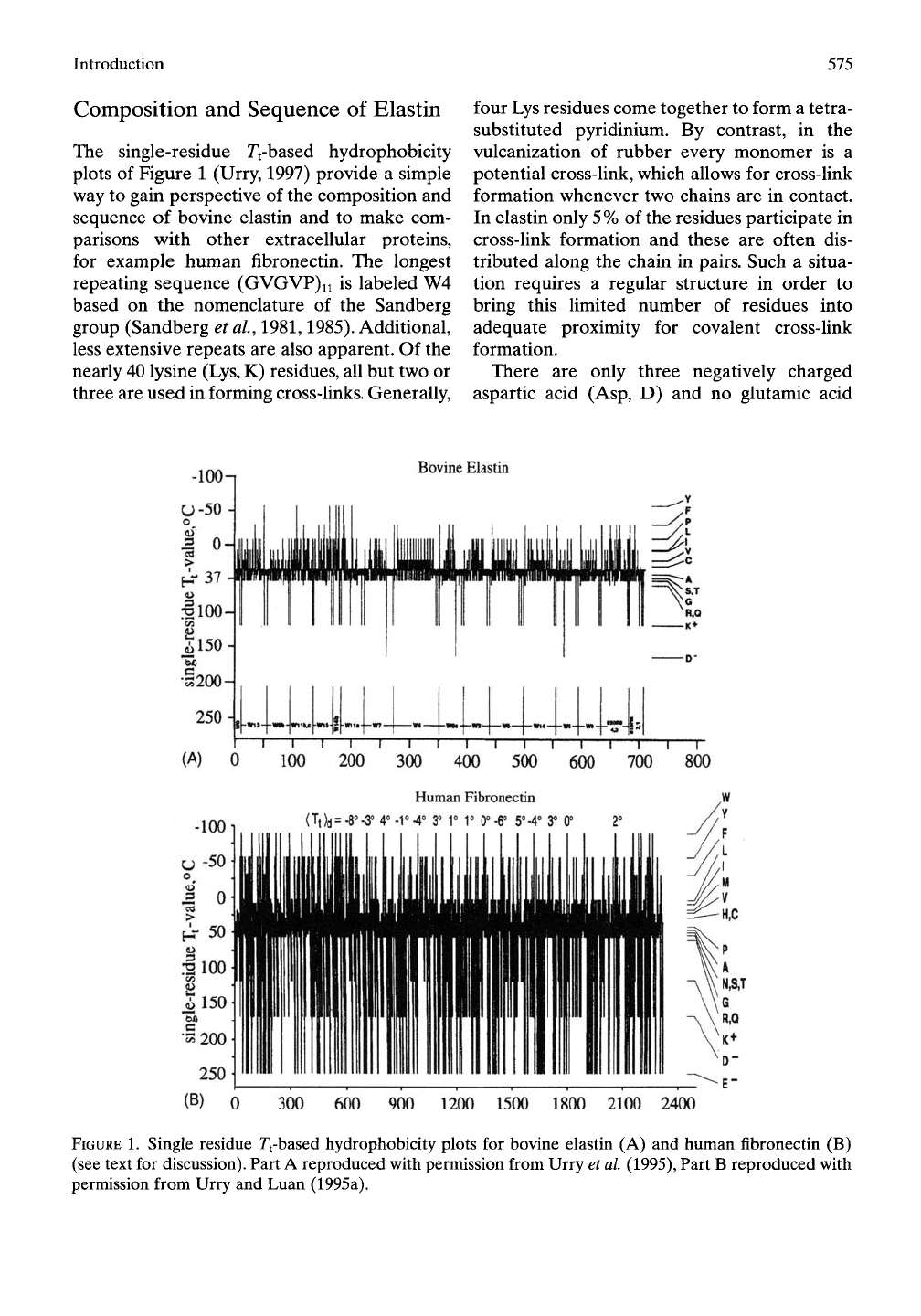
Introduction
575
Composition and Sequence of Elastin
The single-residue Tt-based hydrophobicity
plots of Figure 1 (Urry, 1997) provide a simple
way to gain perspective of the composition and
sequence of bovine elastin and to make com-
parisons with other extracellular proteins,
for example human fibronectin. The longest
repeating sequence (GVGVP)ii is labeled W4
based on the nomenclature of the Sandberg
group (Sandberg et al., 1981,1985). Additional,
less extensive repeats are also apparent. Of the
nearly 40 lysine (Lys, K) residues, all but two or
three are used in forming cross-links. Generally,
four Lys residues come together to form a tetra-
substituted pyridinium. By contrast, in the
vulcanization of rubber every monomer is a
potential cross-link, which allows for cross-link
formation whenever two chains are in contact.
In elastin only 5% of the residues participate in
cross-link formation and these are often dis-
tributed along the chain in pairs. Such a situa-
tion requires a regular structure in order to
bring this limited number of residues into
adequate proximity for covalent cross-link
formation.
There are only three negatively charged
aspartic acid (Asp, D) and no glutamic acid
Bovine Elastin
250
(A)
jmU IMIMLL
||k-«rti<4-«»
—\—I—I—I—I—I—I—I—I—I—I—I—I—I—r
100
200 300 400 500 600 700 800
Human
Fibronectin
I I
300 600 900 1200 1500 1800 2100 2400
FIGURE 1. Single residue Tt-based hydrophobicity plots for bovine elastin (A) and human fibronectin (B)
(see text for discussion). Part A reproduced with permission from Urry et al
(1995),
Part B reproduced with
permission from Urry and Luan (1995a).
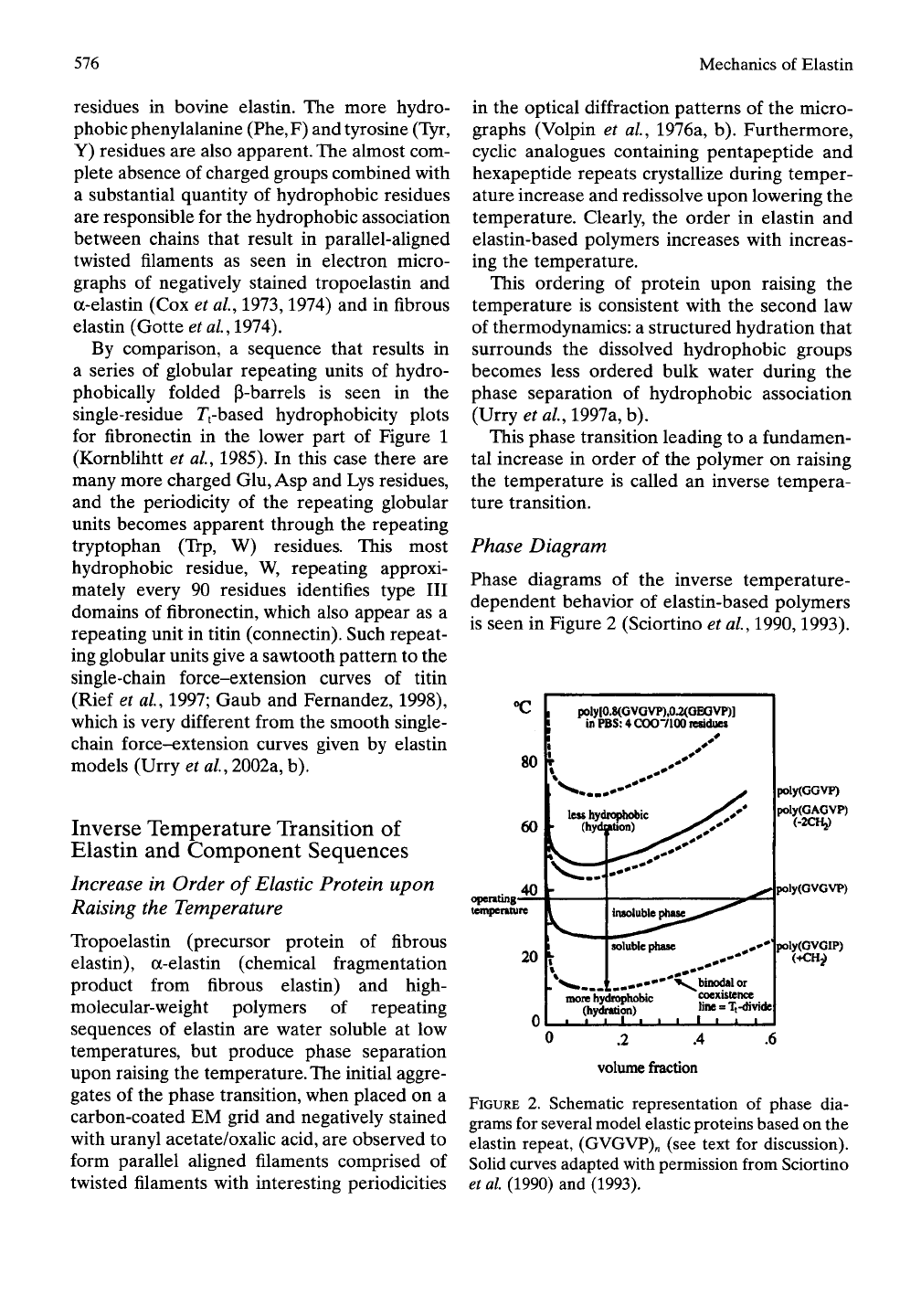
576
Mechanics of Elastin
residues in bovine elastin. The more hydro-
phobic phenylalanine (Phe,F) and tyrosine (Tyr,
Y) residues are also apparent. The almost com-
plete absence of charged groups combined with
a substantial quantity of hydrophobic residues
are responsible for the hydrophobic association
between chains that result in parallel-aUgned
twisted filaments as seen in electron micro-
graphs of negatively stained tropoelastin and
a-elastin (Cox et al, 1973,1974) and in fibrous
elastin (Gotte et al, 191
A).
By comparison, a sequence that results in
a series of globular repeating units of hydro-
phobically folded p-barrels is seen in the
single-residue Tfbased hydrophobicity plots
for fibronectin in the lower part of Figure 1
(Kornblihtt et al, 1985). In this case there are
many more charged Glu, Asp and Lys residues,
and the periodicity of the repeating globular
units becomes apparent through the repeating
tryptophan (Trp, W) residues. This most
hydrophobic residue, W, repeating approxi-
mately every 90 residues identifies type III
domains of fibronectin, which also appear as a
repeating unit in titin (connectin). Such repeat-
ing globular units give a sawtooth pattern to the
single-chain force-extension curves of titin
(Rief et ai, 1997; Gaub and Fernandez, 1998),
which is very different from the smooth single-
chain force-extension curves given by elastin
models (Urry et al, 2002a, b).
Inverse Temperature Transition of
Elastin and Component Sequences
Increase in Order of Elastic Protein upon
Raising the Temperature
Tropoelastin (precursor protein of fibrous
elastin), a-elastin (chemical fragmentation
product from fibrous elastin) and high-
molecular-weight polymers of repeating
sequences of elastin are water soluble at low
temperatures, but produce phase separation
upon raising the temperature. The initial aggre-
gates of the phase transition, when placed on a
carbon-coated EM grid and negatively stained
with uranyl acetate/oxalic acid, are observed to
form parallel aUgned filaments comprised of
twisted filaments with interesting periodicities
in the optical diffraction patterns of the micro-
graphs (Volpin et al, 1976a, b). Furthermore,
cyclic analogues containing pentapeptide and
hexapeptide repeats crystallize during temper-
ature increase and redissolve upon lowering the
temperature. Clearly, the order in elastin and
elastin-based polymers increases with increas-
ing the temperature.
This ordering of protein upon raising the
temperature is consistent with the second law
of thermodynamics: a structured hydration that
surrounds the dissolved hydrophobic groups
becomes less ordered bulk water during the
phase separation of hydrophobic association
(Urry era/., 1997a, b).
This phase transition leading to a fundamen-
tal increase in order of the polymer on raising
the temperature is called an inverse tempera-
ture transition.
Phase Diagram
Phase diagrams of the inverse temperature-
dependent behavior of elastin-based polymers
is seen in Figure 2 (Sciortino et ai, 1990,1993).
XI
operating-
temperature
poly|0.8(GVOVP),0.2(OEGVP)l
in PBS: 4 COO7100 residues
nK>re hydrophobic
(hydration)
^^binodal or
coexistence
line = Tt-divide|
I i I I I
poly(GGVP)
poly(GAGVP)
(-2CH2)
poly(GVGVP)
poly(GVGIP)
,2 .4
volume fraction
.6
FIGURE 2. Schematic representation of phase dia-
grams for several model elastic proteins based on the
elastin repeat, (GVGVP)„ (see text for discussion).
Solid curves adapted with permission from Sciortino
et al (1990) and (1993).
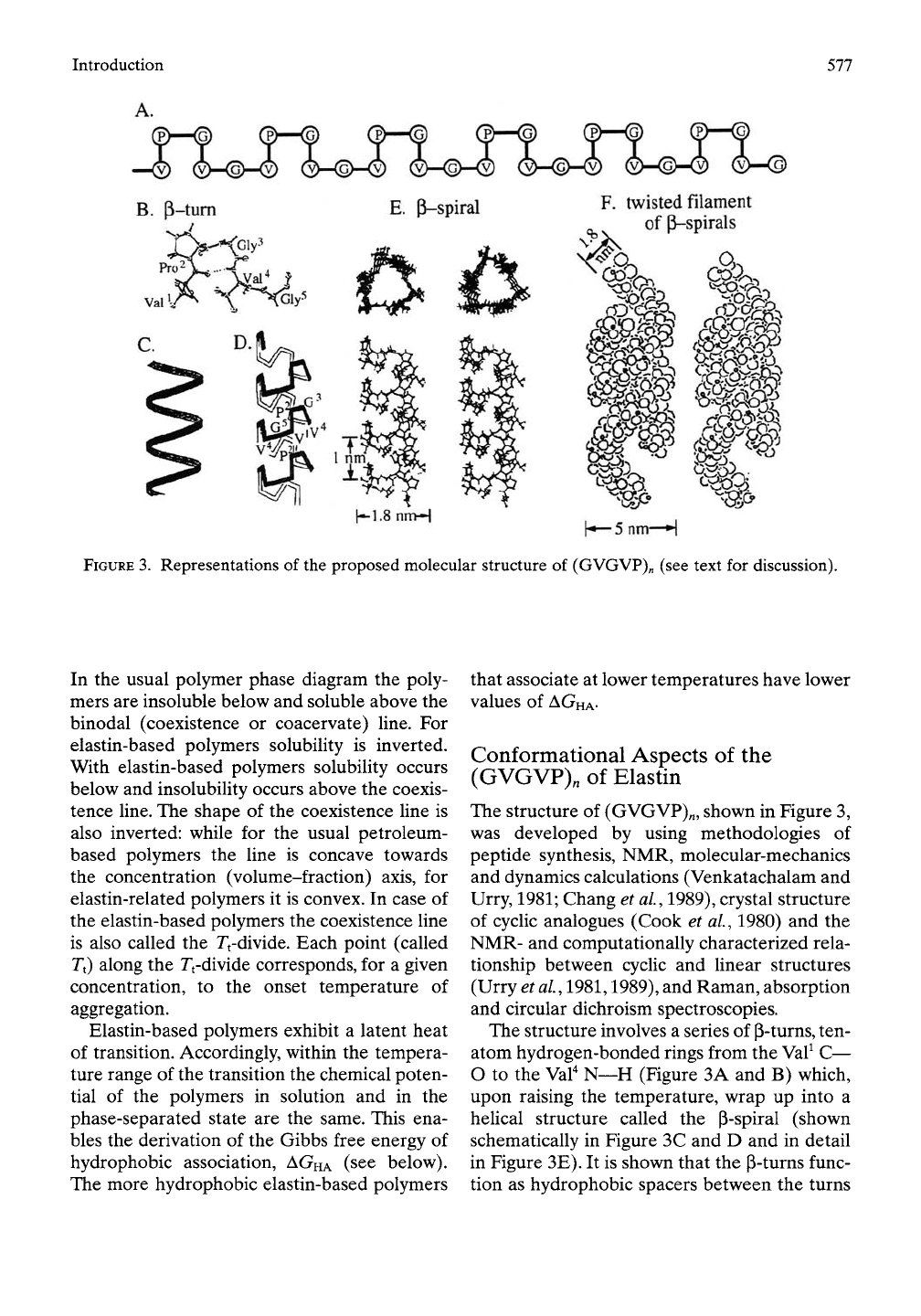
Introduction
577
(P)-HS)
(|)—<S)
(|)—<fi)
(S—© CS—(S) (p)—©
_^
(i>-(g)-<2) (SMsMi) (vMs>-®
GMSMY)
(SMSHS)
<Y>—©
B.
P-tum
J
E.
P-spiral
F.
twisted filament
-^
of|i-spirals
Kl-SnnH
h—5nni—H
FIGURE
3.
Representations of the proposed molecular structure of (GVGVP)„ (see text for discussion).
In the usual polymer phase diagram the poly-
mers are insoluble below and soluble above the
binodal (coexistence or coacervate) line. For
elastin-based polymers solubility is inverted.
With elastin-based polymers solubility occurs
below and insolubility occurs above the coexis-
tence line. The shape of the coexistence line is
also inverted: while for the usual petroleum-
based polymers the line is concave towards
the concentration (volume-fraction) axis, for
elastin-related polymers it is convex. In case of
the elastin-based polymers the coexistence line
is also called the Tt-divide. Each point (called
Tt) along the Tt-divide corresponds, for a given
concentration, to the onset temperature of
aggregation.
Elastin-based polymers exhibit a latent heat
of transition. Accordingly, within the tempera-
ture range of the transition the chemical poten-
tial of the polymers in solution and in the
phase-separated state are the same. This ena-
bles the derivation of the Gibbs free energy of
hydrophobic association,
AGHA
(see below).
TTie more hydrophobic elastin-based polymers
that associate at lower temperatures have lower
values
of
AGHA-
Conformational
Aspects of the
(GVGVP),
of Elastin
The structure of (GVGVP)„, shown in Figure 3,
was developed by using methodologies of
peptide synthesis, NMR, molecular-mechanics
and dynamics calculations (Venkatachalam and
Urry, 1981; Chang et al, 1989), crystal structure
of cyclic analogues (Cook et al., 1980) and the
NMR- and computationally characterized rela-
tionship between cyclic and linear structures
(Urry et al, 1981,1989), and Raman, absorption
and circular dichroism spectroscopies.
The structure involves a series of P-turns, ten-
atom hydrogen-bonded rings from the Val^ C—
O to the Val^ N—H (Figure 3A and B) which,
upon raising the temperature, wrap up into a
helical structure called the p-spiral (shown
schematically in Figure 3C and D and in detail
in Figure 3E). It is shown that the P-turns func-
tion as hydrophobic spacers between the turns
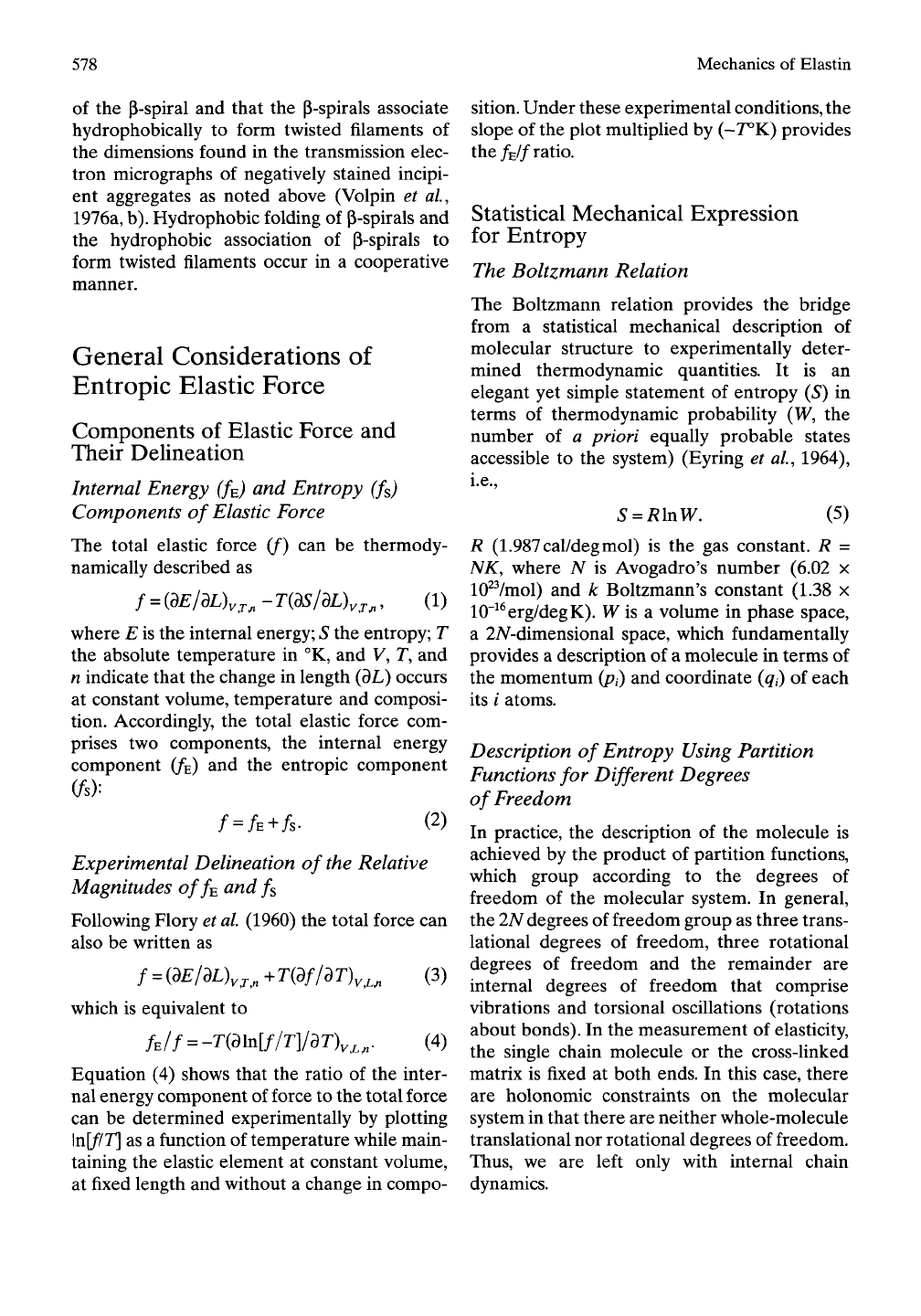
578
Mechanics of Elastin
of the p-spiral and that the (J-spirals associate
hydrophobically to form twisted filaments of
the dimensions found in the transmission elec-
tron micrographs of negatively stained incipi-
ent aggregates as noted above (Volpin et al,
1976a, b). Hydrophobic folding of P-spirals and
the hydrophobic association of P-spirals to
form twisted filaments occur in a cooperative
manner.
General
Considerations of
Entropic
Elastic Force
Components
of Elastic Force and
Their
Delineation
Internal Energy (/E) and Entropy (fs)
Components of Elastic Force
The total elastic force (/) can be thermody-
namically described as
/
= (dE/dL)y^^^ - T{dS/dL)y,,^, (1)
where E is the internal energy; S the entropy; T
the absolute temperature in °K, and V, T, and
n indicate that the change in length (3L) occurs
at constant volume, temperature and composi-
tion. Accordingly, the total elastic force com-
prises two components, the internal energy
component (/E) and the entropic component
(7s):
/
=
/E+/S.
(2)
Experimental Delineation of the Relative
Magnitudes off^ and fs
Following Flory et al (1960) the total force can
also be written as
f^idE/dL)y^^+T{df/dT)y^^
which is equivalent to
fE/f =
-T{dln[f/T]/dT)
V,Ln'
(3)
(4)
Equation (4) shows that the ratio of the inter-
nal energy component of force to the total force
can be determined experimentally by plotting
ln[/7r] as a function of temperature while main-
taining the elastic element at constant volume,
at fixed length and without a change in compo-
sition. Under these experimental conditions, the
slope of the plot multipUed by (-7^K) provides
the/E//ratio.
Statistical
Mechanical Expression
for
Entropy
The Boltzmann Relation
The Boltzmann relation provides the bridge
from a statistical mechanical description of
molecular structure to experimentally deter-
mined thermodynamic quantities. It is an
elegant yet simple statement of entropy (5) in
terms of thermodynamic probability (W, the
number of a priori equally probable states
accessible to the system) (Eyring et al., 1964),
i.e..
S
=
R\nW.
(5)
R (1.987 cal/degmol) is the gas constant. R =
NK, where A^ is Avogadro's number (6.02 x
10^^/mol) and k Boltzmann's constant (1.38 x
10"^^erg/degK). W is a volume in phase space,
a 2N-dimensional space, which fundamentally
provides a description of a molecule in terms of
the momentum (pi) and coordinate (qi) of each
its / atoms.
Description of Entropy Using Partition
Functions for Different Degrees
of Freedom
In practice, the description of the molecule is
achieved by the product of partition functions,
which group according to the degrees of
freedom of the molecular system. In general,
the 2N degrees of freedom group as three trans-
lational degrees of freedom, three rotational
degrees of freedom and the remainder are
internal degrees of freedom that comprise
vibrations and torsional oscillations (rotations
about bonds). In the measurement of elasticity,
the single chain molecule or the cross-linked
matrix is fixed at both ends. In this case, there
are holonomic constraints on the molecular
system in that there are neither whole-molecule
translational nor rotational degrees of freedom.
Thus,
we are left only with internal chain
dynamics.

The Physical Basis
for
Entropic Elasticity
in
Elastin 579
Frequency Dependence
of
Entropy
for the
Harmonic Oscillator Representation
of
Internal Chain Dynamics
The harmonic oscillator partition function
(/v)
provides
a
relatively simple
and yet
informative
representation
of
internal chain dynamics.
f^=[\-tx^{-hvJkT)Y\
(6)
When placed
in
Equation
(5) and
expressed
in
terms
of the
frequency-dependence
of
entropy
(5)
we
obtain (Dauber
et al,
1981),
5,
=
7?{ln[l
-
exp(-/z
V,
IkT)]''
+
{hv,
/kT)[txp{hv,
IkT)
-1]-'}.
(7)
Equation
(7) is
plotted
in
Figure
4
with
5/ on
the left-hand ordinate
and
with
the
free-energy
contribution
{TS) on the
right-hand ordinate.
The interesting features
of
Figure
4 are
that
the vibrational modes occur
at
high frequencies
where
the
contribution
to
entropy
is
small,
and
the torsional oscillations occur
at
much lower
frequencies where
the
contribution
to
entropy
is much larger. As discussed below, the mechan-
ical resonances exhibited
by
elastin models
and
fibrous elastin occur
at
frequencies near
1
kHz
and
5
MHz, i.e., near
3 and 6 on the
abscissa
of
Figure
4.
Accordingly,
it
becomes reasonable
to
neglect changes
in
vibrational frequencies
on
extension
and to
consider those configurational
and dynamic changes
due to
changes
in
torsion
angles.
Expression
for the
Change
in
Entropy
on Extension
The change
in
entropy upon extension
is
written,
^S
=
{S'-S')
=
R\n{W'IW'\
(8)
where
e and r
stand
for the
extended
and
relaxed states. With Equation
(8) it
becomes
possible
to use
both molecular mechanics
and
dynamics calculations
of the
molecular struc-
ture described
in
Figure
3 to
calculate
the
con-
tribution
of
torsional freedom
of the
structure
to entropy
in
both
the
relaxed
and
extended
states.
5,
=
/?[in(i-^-*"''*''r'
+(Av,/*rxe*''''*''
-ir'i
I
e
w
40
30
20 h
^
10
K
KJ
1 M M M 1 1 1 M 1
1
1 1 1
1
H
1
irH
1
i 111
M
1'
11 M
111
i
11'' 11'
11
i
11 M
i' ' ''
111 rpLl M 11111 1111111111 M
1
M1111111111IJ
II
rnH.]
11 i 1
111111111
1 11 11
1
1111
rrj^
1 111 i
11111
1
1
111
1
i
11
i
M
111 rjsj
11111
1
''•''•'
11'
M
11
n
11
11 1
ipLJ 11111
11 i 1
1
11 1 1 i
ITM
11 1 i
1 1 1
1
1
1 1111 rrMj 11
i
1
11
ill
1
li^
'''''Mill
1
1 1
11111
ij
111
li^i 1111IIII11
1
1 1 1
1 1
1
1 1 1 1
\\T\
1
11111 i
1
1111
1
rbrL
II
1
11
1 1
i 1
11111
111
rrH
In
1 j
11 1111 11 11111
111
11^
II
11111II11
il
1II1II1111111111II111 Ti^l Mill
1
1 1
1 1
11
1 1 11 11 1 1 1
1
ipLJ
n
11111II1II1111111111111111II1111II11 rNJ
1
114
Q
00
OS
110
S
'I
6
8
logt).
10
12
FIGURE
4.
Plot, based on the harmonic oscillator par-
tition function,
of the
entropy
of the
oscillator
as a
function
of
log(oscillator frequency).
On the
left-
hand ordinate
is
plotted
the
entropy
in
cal/mol
deg
(EU, entropy units),
and on the
right-hand ordinate
is plotted the entropic contribution
to
the Gibbs free
energy
in
kcal/mol pentamer
at
298°K. This illus-
trates
the
increasing contribution
of low
frequency
oscillations
to the
entropy
and
free energy
of a
protein chain segment. Adapted with permission
from Urry et
al
(1988).
The Physical Basis
for
Entropic
Elasticity
in
Elastin
In
an
ideal
or
perfect elastomer
the
energy
repeatedly invested
in
extension
is
repeatedly
and completely recovered during relaxation.
Ideality increases
as the
elastic force results
from
a
decrease
in
entropy upon extension,
because this occurs without stressing bonds
to
the breaking point. Elastin models
and
elastin
itself
in
water provide examples
of
such
entropic elastomers with about
90% of the
elastic force being entropic, that
is,
the
/E//ratio
of Equation
(4) is
about
0.1.
This
is
essential
to
human life expectancy, because
the
half-hfe
of
elastin
in the
mammahan elastic fiber
is on the
order
of 70
years. This means that
the
elastic
fibers of
the
aortic arch
and
thoracic aorta,
where there
is
twice
as
much elastin
as
colla-
gen, will have survived some biUion demanding
stretch-relaxation cycles
by the
start
of the
seventh decade
of
life. This represents
an
ulti-
mate
in
ideal elasticity.
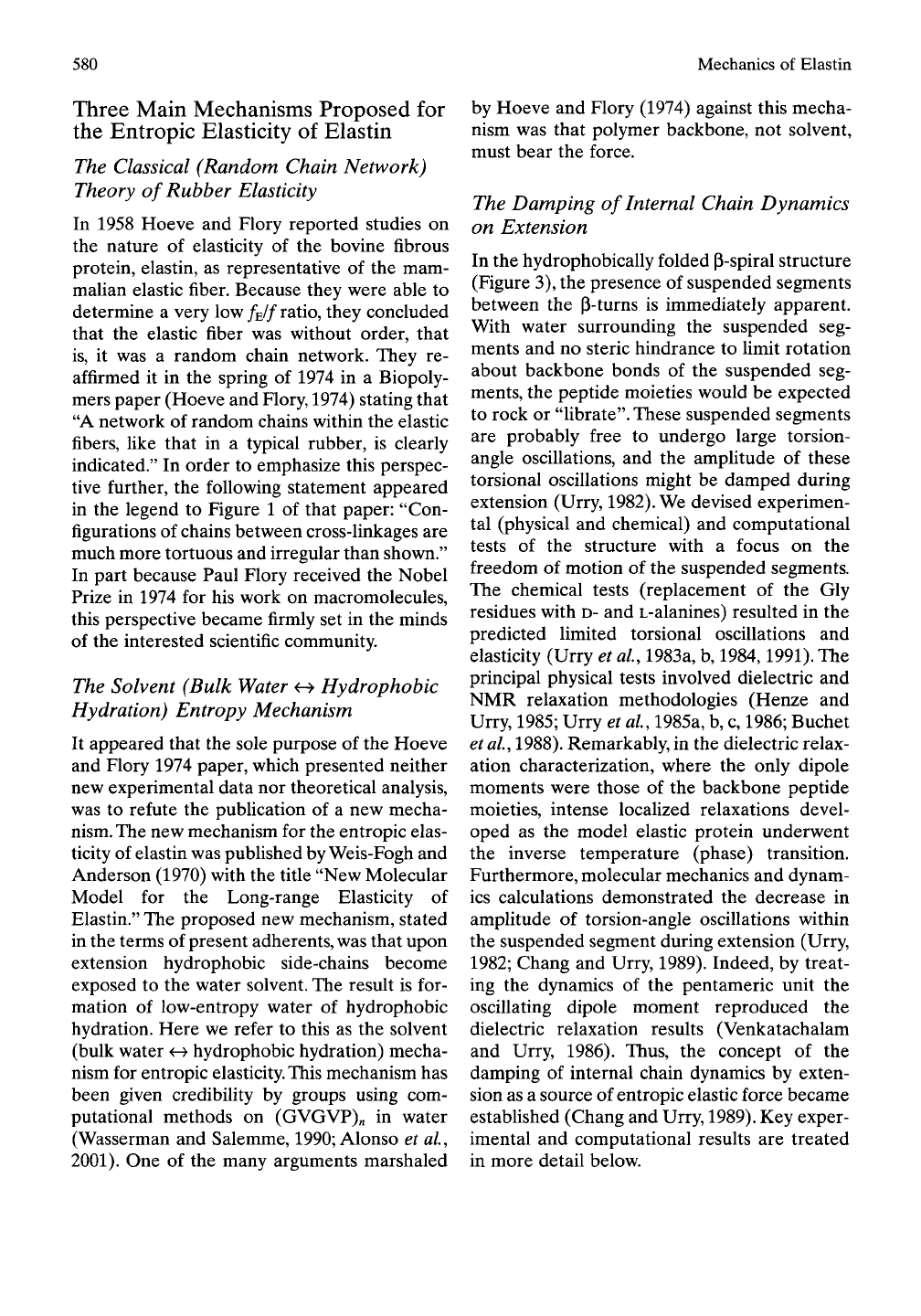
580 Mechanics
of Elastin
Three
Main Mechanisms Proposed for
the
Entropic Elasticity of Elastin
The Classical (Random Chain Network)
Theory of Rubber Elasticity
In 1958 Hoeve and Flory reported studies on
the nature of elasticity of the bovine fibrous
protein, elastin, as representative of the mam-
malian elastic fiber. Because they were able to
determine a very
low/E//ratio,
they concluded
that the elastic fiber was without order, that
is,
it was a random chain network. They re-
affirmed it in the spring of 1974 in a Biopoly-
mers paper (Hoeve and
Flory,
1974) stating that
"A network of random chains within the elastic
fibers, like that in a typical rubber, is clearly
indicated." In order to emphasize this perspec-
tive further, the following statement appeared
in the legend to Figure 1 of that paper: "Con-
figurations of chains between cross-linkages are
much more tortuous and irregular than shown."
In part because Paul Flory received the Nobel
Prize in 1974 for his work on macromolecules,
this perspective became firmly set in the minds
of the interested scientific community.
The Solvent (Bulk Water <-> Hydrophobic
Hydration) Entropy Mechanism
It appeared that the sole purpose of the Hoeve
and Flory 1974 paper, which presented neither
new experimental data nor theoretical analysis,
was to refute the publication of a new mecha-
nism.
The
new mechanism for the entropic elas-
ticity of elastin was pubUshed
by
Weis-Fogh and
Anderson (1970) with the title "New Molecular
Model for the Long-range Elasticity of
Elastin." The proposed new mechanism, stated
in the terms of present
adherents,
was
that upon
extension hydrophobic side-chains become
exposed to the water solvent. The result is for-
mation of low-entropy water of hydrophobic
hydration. Here we refer to this as the solvent
(bulk water
<-^
hydrophobic hydration) mecha-
nism for entropic
elasticity.
This
mechanism has
been given credibility by groups using com-
putational methods on (GVGVP)„ in water
(Wasserman and Salemme,
1990;
Alonso et al,
2001).
One of the many arguments marshaled
by Hoeve and Flory (1974) against this mecha-
nism was that polymer backbone, not solvent,
must bear the force.
The Damping of Internal Chain Dynamics
on Extension
In the hydrophobically folded ^-spiral structure
(Figure
3),
the presence of suspended segments
between the (i-turns is immediately apparent.
With water surrounding the suspended seg-
ments and no steric hindrance to limit rotation
about backbone bonds of the suspended seg-
ments,
the peptide moieties would be expected
to rock or
"librate".
These suspended segments
are probably free to undergo large torsion-
angle oscillations, and the amplitude of these
torsional oscillations might be damped during
extension (Urry,
1982).
We devised experimen-
tal (physical and chemical) and computational
tests of the structure with a focus on the
freedom of motion of the suspended segments.
The chemical tests (replacement of the Gly
residues with
D-
and L-alanines) resulted in the
predicted limited torsional oscillations and
elasticity (Urry et al, 1983a, b, 1984,1991). The
principal physical tests involved dielectric and
NMR relaxation methodologies (Henze and
Urry,
1985;
Urry et al, 1985a, b, c, 1986; Buchet
et
ai,
1988).
Remarkably, in the dielectric relax-
ation characterization, where the only dipole
moments were those of the backbone peptide
moieties, intense localized relaxations devel-
oped as the model elastic protein underwent
the inverse temperature (phase) transition.
Furthermore, molecular mechanics and dynam-
ics calculations demonstrated the decrease in
amplitude of torsion-angle oscillations within
the suspended segment during extension (Urry,
1982;
Chang and Urry, 1989). Indeed, by treat-
ing the dynamics of the pentameric unit the
oscillating dipole moment reproduced the
dielectric relaxation results (Venkatachalam
and Urry, 1986). Thus, the concept of the
damping of internal chain dynamics by exten-
sion as a source of entropic elastic force became
estabHshed (Chang and Urry,
1989).
Key exper-
imental and computational results are treated
in more detail below.
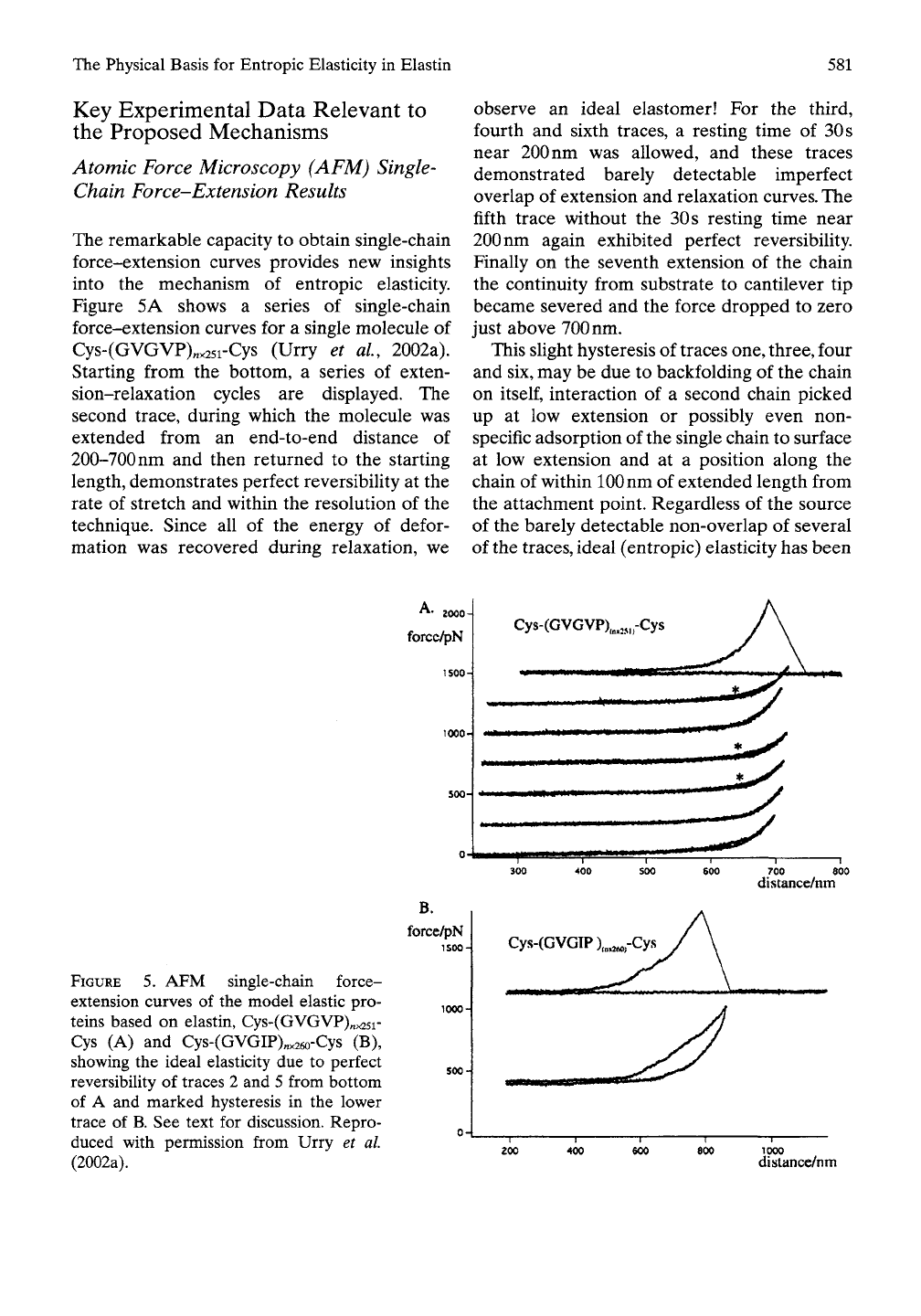
The Physical Basis for Entropic Elasticity in Elastin
581
Key Experimental Data Relevant to
the Proposed Mechanisms
Atomic Force Microscopy (AFM) Single-
Chain Force-Extension Results
The remarkable capacity to obtain single-chain
force-extension curves provides new insights
into the mechanism of entropic elasticity.
Figure 5A shows a series of single-chain
force-extension curves for a single molecule of
Cys-(GVGVP)„x25i-Cys (Urry et al, 2002a).
Starting from the bottom, a series of exten-
sion-relaxation cycles are displayed. The
second trace, during which the molecule was
extended from an end-to-end distance of
200-700 nm and then returned to the starting
length, demonstrates perfect reversibility at the
rate of stretch and within the resolution of the
technique. Since all of the energy of defor-
mation was recovered during relaxation, we
observe an ideal elastomer! For the third,
fourth and sixth traces, a resting time of
30 s
near 200 nm was allowed, and these traces
demonstrated barely detectable imperfect
overlap of extension and relaxation curves. The
fifth trace without the
30 s
resting time near
200
nm again exhibited perfect reversibihty.
Finally on the seventh extension of the chain
the continuity from substrate to cantilever tip
became severed and the force dropped to zero
just above 700 nm.
This shght hysteresis of traces one, three, four
and six, may be due to backfolding of the chain
on
itself,
interaction of a second chain picked
up at low extension or possibly even non-
specific adsorption of the single chain to surface
at low extension and at a position along the
chain of within lOOnm of extended length from
the attachment point. Regardless of the source
of the barely detectable non-overlap of several
of the traces, ideal (entropic) elasticity has been
FIGURE 5. AFM single-chain force-
extension curves of the model elastic pro-
teins based on elastin, Cys-(GVGVP)„^5i-
Cys (A) and Cys-(GVGIP)„x26o-Cys (B),
showing the ideal elasticity due to perfect
reversibility of traces 2 and 5 from bottom
of A and marked hysteresis in the lower
trace of B. See text for discussion. Repro-
duced with permission from Urry et al
(2002a).
A 2000.
forcc/pN
1S00-
Cys-(GVGVP),„„„-Cys
500-^
I II • WiHil
B.
force/pN
300 400 SOO
Cys-(GVGTP),„.^,-Cys
700 800
distance/nm
—I—
400
—I—
600
1000
distancc/nm
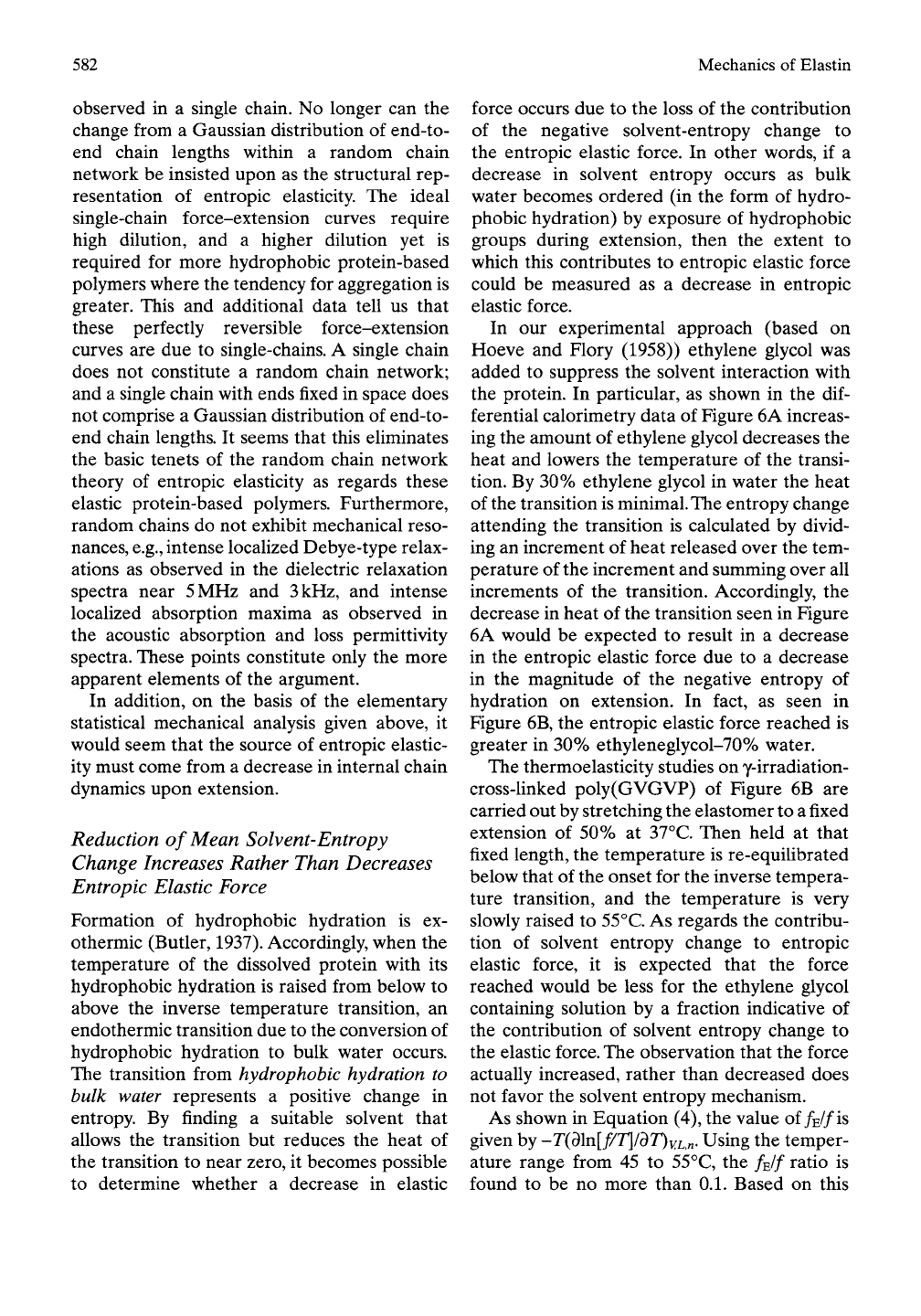
582
Mechanics of Elastin
observed in a single chain. No longer can the
change from a Gaussian distribution of end-to-
end chain lengths within a random chain
network be insisted upon as the structural rep-
resentation of entropic elasticity. The ideal
single-chain force-extension curves require
high dilution, and a higher dilution yet is
required for more hydrophobic protein-based
polymers where the tendency for aggregation is
greater. This and additional data tell us that
these perfectly reversible force-extension
curves are due to single-chains. A single chain
does not constitute a random chain network;
and a single chain with ends fixed in space does
not comprise a Gaussian distribution of end-to-
end chain lengths. It seems that this eliminates
the basic tenets of the random chain network
theory of entropic elasticity as regards these
elastic protein-based polymers. Furthermore,
random chains do not exhibit mechanical reso-
nances, e.g., intense localized Debye-type relax-
ations as observed in the dielectric relaxation
spectra near
5
MHz and
3
kHz, and intense
localized absorption maxima as observed in
the acoustic absorption and loss permittivity
spectra. These points constitute only the more
apparent elements of the argument.
In addition, on the basis of the elementary
statistical mechanical analysis given above, it
would seem that the source of entropic elastic-
ity must come from a decrease in internal chain
dynamics upon extension.
Reduction of Mean Solvent-Entropy
Change Increases Rather Than Decreases
Entropic Elastic Force
Formation of hydrophobic hydration is ex-
othermic (Butler, 1937). Accordingly, when the
temperature of the dissolved protein with its
hydrophobic hydration is raised from below to
above the inverse temperature transition, an
endothermic transition due to the conversion of
hydrophobic hydration to bulk water occurs.
The transition from hydrophobic hydration to
bulk water represents a positive change in
entropy. By finding a suitable solvent that
allows the transition but reduces the heat of
the transition to near zero, it becomes possible
to determine whether a decrease in elastic
force occurs due to the loss of the contribution
of the negative solvent-entropy change to
the entropic elastic force. In other words, if a
decrease in solvent entropy occurs as bulk
water becomes ordered (in the form of hydro-
phobic hydration) by exposure of hydrophobic
groups during extension, then the extent to
which this contributes to entropic elastic force
could be measured as a decrease in entropic
elastic force.
In our experimental approach (based on
Hoeve and Flory (1958)) ethylene glycol was
added to suppress the solvent interaction with
the protein. In particular, as shown in the
dif-
ferential calorimetry data of Figure 6A increas-
ing the amount of ethylene glycol decreases the
heat and lowers the temperature of the transi-
tion. By 30% ethylene glycol in water the heat
of the transition is minimal. The entropy change
attending the transition is calculated by divid-
ing an increment of heat released over the tem-
perature of the increment and summing over all
increments of the transition. Accordingly, the
decrease in heat of the transition seen in Figure
6A would be expected to result in a decrease
in the entropic elastic force due to a decrease
in the magnitude of the negative entropy of
hydration on extension. In fact, as seen in
Figure 6B, the entropic elastic force reached is
greater in 30% ethyleneglycol-70% water.
The thermoelasticity studies on y-irradiation-
cross-linked poly(GVGVP) of Figure 6B are
carried out by stretching the elastomer to a fixed
extension of 50% at 37°C. Then held at that
fixed length, the temperature is re-equilibrated
below that of the onset for the inverse tempera-
ture transition, and the temperature is very
slowly raised to 55°C. As regards the contribu-
tion of solvent entropy change to entropic
elastic force, it is expected that the force
reached would be less for the ethylene glycol
containing solution by a fraction indicative of
the contribution of solvent entropy change to
the elastic force. The observation that the force
actually increased, rather than decreased does
not favor the solvent entropy mechanism.
As shown in Equation (4), the value
of/EZ/IS
given by -T(d\n[f/T]/dT)v,L,n' Using the temper-
ature range from 45 to 55°C, the f^f ratio is
found to be no more than 0.1. Based on this

The Physical Basis for Entropic Elasticity in Elastin
583
FIGURE
6. (A) Differential calorimetry
curves as a function of ethylene glycol
(EG) in water. Note the decrease in the
heat and lowering of the temperature
range of the transition as the amount of
ethylene glycol is raised to 30%. B. Ther-
moelasticity
curves,
plots of \og(flT)
vs.
T at
fixed length, for 20 Mrad y-irradiation
cross-linked poly(GVGVP). The f^lf ratio,
determined from the slope above 45°C for
both solvent conditions, is less than or
equal to
0.1,
that is the entropic component
of elastic force is 90% or greater. Signifi-
cantly, addition of ethylene glycol (EG)
results in an increase in entropic elastic
force suggesting that slovent entropy
change is not a contribution to the entropic
elastic force. Reproduced with permission
from Luan et al (1989).
A.
poly(GVGVP)
inEGrHiO
10
—1—
20
—I r—
30 40
temperature,
50
60
—r-
70
—I
80
B.
:N
-0.5
-1.5
-2.5
-3.5
X^-poly(GVGVP)
EGrHjO; 30:70
fe/f < 0.1
.#*•'
EG:H2O;0:l
15 25 35
Temperature, *C
45
55
analysis using Equation (4), the/^Z/value would
be 0.9 or greater, and yet this entropic elastic
force would appear not to come from a change
in solvent entropy. Even more telling is the
increase in force at fixed length, (df/dT)L, as
the temperature is raised through the range of
the inverse temperature transition. As will be
discussed below, this thermally driven isometric
contraction shows an increase in force under
conditions of an increase rather than the
required decrease in solvent entropy.
Presence of Mechanical Resonances in
Elastin Models and Elastin Itself
(i) Mechanical resonances in the acoustic
frequency range: The elastic models of elastin
based on the pentameric repeat (GVGVP)
and analogues
thereof,
such as (GVGIP),
exhibit mechanical resonances in the acoustic
frequency range of
100
Hz to
7
kHz. This is
seen in Figure 7A for y-irradiation-cross-linked
(GVGIP)26o» which exhibits a mechanical reso-
nance of increasing absorption intensity as the
temperature is raised from below to above the
range of the inverse temperature transition
(Urry et al, 2002a). By contrast, natural rubber
and polyurethane (a particularly good elas-
tomer for sound absorption), exhibit only broad
low-intensity absorption as might be expected
for a random chain network. For a random
chain the frequency for rotation about each
polymer backbone bond will be different,
whereas for an elastomer with a regular re-
peating structure such as that in Figure 3
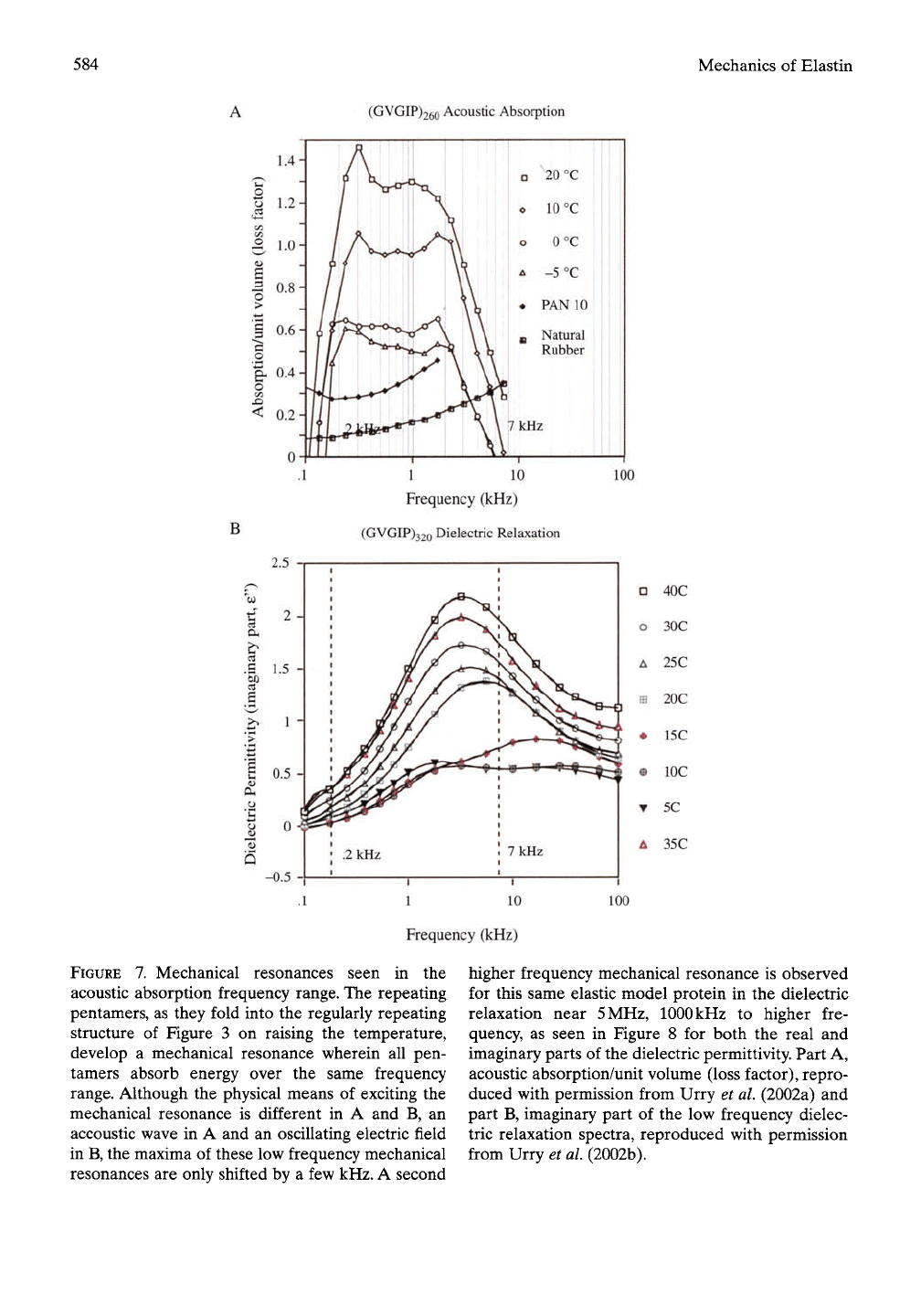
584
Mechanics of Elastin
(GVGIP)26o Acoustic Absorption
^
o
^
M-i
c«
c/}
O^
<D
B
>
•*-»
'B
o
1
1^
JD
<
1.4-
1.2-
1.0-
0.8-
_
0.6-
-
0.4-
-
0.2-
0-
r
"s^^rf^a^-
°
/ \^ ^
/ /v ^y^^\ ®
/ / \ \ ^
/ / \ 0 *
lit ^Tltt— JL\. \ \ B
20 °C
10 °C
o°c
-5°C
PAN 10
Natural
Rubber
mo
fcijp^r.-y^'*^^^
\ \ 7 kHz 1
LLl , Al-- 1
>
'B
o
s
s
1 10
Frequency (kHz)
(GVGIP)32o Dielectric Relaxation
100
-0.5
Frequency (kHz)
FIGURE
7. Mechanical resonances seen in the
acoustic absorption frequency range. The repeating
pentamers, as they fold into the regularly repeating
structure of Figure 3 on raising the temperature,
develop a mechanical resonance wherein all pen-
tamers absorb energy over the same frequency
range. Although the physical means of exciting the
mechanical resonance is different in A and B, an
accoustic wave in A and an oscillating electric field
in B, the maxima of these low frequency mechanical
resonances are only shifted by a few kHz. A second
higher frequency mechanical resonance is observed
for this same elastic model protein in the dielectric
relaxation near
5
MHz, 1000 kHz to higher fre-
quency, as seen in Figure 8 for both the real and
imaginary parts of the dielectric permittivity. Part A,
acoustic absorption/unit volume (loss factor), repro-
duced with permission from Urry et al. (2002a) and
part B, imaginary part of the low frequency dielec-
tric relaxation spectra, reproduced with permission
from Urry et al (2002b).
